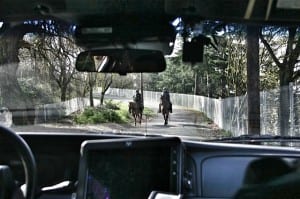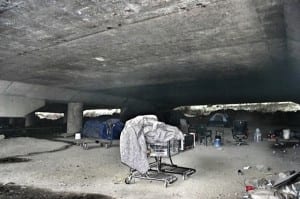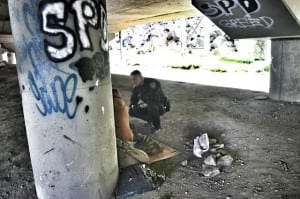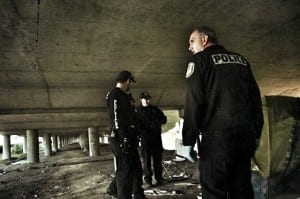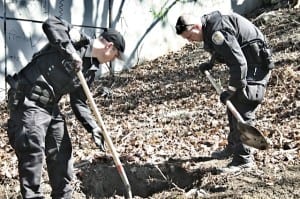
After a day of crisscrossing overgrown, muddy pathways along the west side of Beacon Hill Monday, three South Precinct officers stand on a leaf-covered hillside just below Holgate Street, digging up a patch of dirt.
They’re looking for a body.
Recently, Beacon Hill neighbors have reported gunfire rumbling through the greenbelt on the west side of Beacon Hill, colloquially referred to in the neighborhood as “the Jungle.”
While police haven’t received any specific reports of anyone being injured in the greenbelt, on Monday, about 40 officers from the Seattle Police Department’s South Precinct patrol, Anti-Crime Team, Community Police Team, mounted patrol, and the Department of Corrections combed through the forest on Beacon Hill. Their goal: find any weapons which might be hidden in the woods, and locate any shooting victims.
Every day, thousands of people drive past the greenbelt—which sits on a Washington State Department of Transportation property along Interstate 5, stretching all the way up the South Precinct—or pass through it on the newly opened Mountain to Sound Trail, which rolls along Beacon Hill’s west slope. But the greenbelt’s forest canopy also serves as a shield from the elements for the many homeless men and women who live in encampments tucked into the wooded hillside. That same canopy, unfortunately, also provides cover for drug dealers and other criminals.
“This is about safety issues, not displacing people,” says South Precinct Anti-Crime Team Sgt. John Brooks, who took part in Monday’s search. The seven hour operation took officers up and down gravel-and-cardboard lined pathways, and across slick, muddy hillsides littered with old clothes, discarded blankets, bottles, cans, and frozen burrito wrappers.
Navigating their way across the thick, wet clay mud under I-5, a group of four officers call out to the men and women sleeping inside a small camp near South Holgate Street.
“Seattle police,” the officers announce as they approach the tents. “Can you poke your heads out?”
While checking on the men and women inside the tents, officers also ask whether they’ve heard gunfire or know about any other trouble spots in the greenbelt.
One of the men living under I-5, Michael, chats with one of the officers. “It’s good to see you guys roll by,” he says.
Michael’s been homeless for 9 years. He works in a food bank, but spends much of his time in a small camp under I-5, surrounded by a series of elaborate chalk murals and scrawled pieces of scripture.
An eight year old felony case has made it hard to get off the streets and into housing, Michael says. And, if he ever moves out from under the freeway, he jokes, he’d have to take his art—and the concrete freeway supports he’s turned into a canvas—with him.
Michael says he’s gotten used to the roar of freeway traffic and constant percussive clang of the metal joints and concrete just over his head, but lately he, too, has noticed gunshots coming from the greenbelt. “There’s shootings, there’s gunfire,” he says, adding that the gunshots are the result of a “rivalry” between two groups of “crack dealers” who hang out around the woods.
One officer asks Michael if he needs help getting into a shelter. He declines, saying he likes the privacy of his camp under the freeway.
The greenbelt’s treacherous terrain, unmarked pathways, and uncharted encampments certainly do allow for privacy. They’ve also long posed a challenge for police, making it difficult to regularly check on the people living along the hillside, who may need help.
Because of the difficulties in searching and navigating such a large, overgrown area, South Precinct ACT Sgt. Brooks estimates the department has only performed large-scale treks through the Beacon Hill greenbelt two or three times in the last decade.
To aid in Monday’s search, members of the SPD’s Arson/Bomb Squad, ATF, and King County Sheriff’s office brought in specially trained dogs, capable out sniffing out explosives, guns, or victims of violent crimes.
By mid-day, two of the search and rescue dogs—trained to detect human remains—have taken an interest in a patch of hillside overlooking I-5, just below South Holgate Street.
“It could be blood, human remains, bloody clothing, or a tooth,” says one dog’s handler, as three South Precinct officers—Victor Pirak, Derek Ristau and Adam Wilkes—grab shovels and begin to dig, in the chance that a lifeless body might be waiting for them below the loose dirt on the hillside.
After a tense 20 minutes, Officer Ristau digs up a surgical mask, buried about a foot underground. The excavation doesn’t turn up anything else, and the dogs seem to lose interest in the patch of ground. The officers seem relieved, just as they were earlier in the day when another group of search and rescue dogs led officers to a pile of bones near Jose Rizal Park, which turned out to belong to an animal.
At the end of the day, police haven’t turned up any victims of violent crime or found any weapons hidden in the thick forest canopy.
But officers did contact more than 150 people living around the Beacon Hill greenbelt, and now have a feel for the rough terrain, as well as an idea of where and how the apparently growing population in the greenbelt lives.
“It’s kind of sad to see,” says South Precinct ACT Officer Maurice Washington, who helped coordinate Monday’s search. “They’re kind of forgotten in some ways.”
In the next week, South Precinct’s Community Police Team will accompany social workers and members of the Department of Neighborhoods through the greenbelt to see if they can connect any of Beacon Hill’s forgotten residents with social services.
